A Plus Optometry is proud to have a dedicated Myopia Control Clinic where we use a group of methods to try and slow the progression of childhood myopia.
A Plus Optometry is proud to have a dedicated Myopia Control Clinic where we use a group of methods to try and slow the progression of childhood myopia.

Myopia is known to be associated with serious eye conditions that can cause irreversible blindness, and the risk factors increases as one becomes more and more short-sighted.
The prevalence of Myopia in the general Australian population, especially in children, have increased by a few folds since 2019 and it is estimated by 2050, 50% of the world’s population will be myopic!
Unfortunately, no amount of myopia is considered safe, this is due to the above-mentioned risk factors for eye diseases.
As one of the most important field of optometry that prevents eye diseases in the 21st century, A Plus Optometry is proud to have a dedicated Myopia Control Clinic in Melbourne serving all the surrounding suburbs including:
Myopia, also known as short-sightedness, is mostly presented with symptoms of:
Myopia affects all age groups; however, it is most problematic for children, especially from the age of 6 to 13.
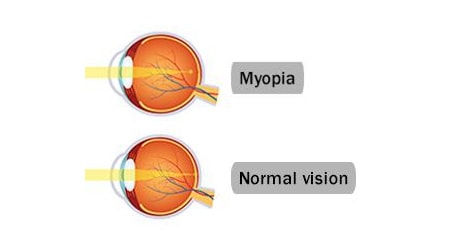
The current research suggests the excessive axial elongation of the eyeball may be largely driven by “hyperopic peripheral defocus”. This is where the rays of the light coming from the side get focused behind the peripheral retina. Since the light is focused behind the retina, it signals the eyeball to grow longer to “catch up” with the defocused lights, hence elongation of the eyeball and worsening of myopia.
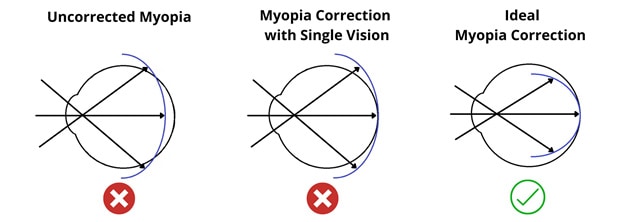
There have been many scientific journals published in the last few decades that have agreed upon the contributing factors to the worsening of myopia. There are many different factors, but the most significant contributors are genetics, race, age, visual environmental factors, and the undercorrection/overcorrection of spectacles.
Family history plays a big part in myopia. If one of your parents is myopic, you are three times more likely to be short-sighted, if both of your parents are myopic then you are six times more likely to be myopic. However, you can still develop myopia without having immediate family members who have it.
Children of Asian descent are also much more likely to become myopic then ones from Caucasian descent.
Furthermore, children that have become short-sighted at a younger age tend to develop more severe myopia later in life. This is because the younger the child, the faster the eyeball grows, and researchers have found children before the age of 13 are more likely to have abnormal and excessive eyeball growth which results in great severity of myopia later in life. Fortunately, for most people, the eyeballs will stop growing past a certain age, though this age differs upon individual.
The one factor that we have more control over and that is the visual environmental factors. Myopia tends to develop faster with excessive near work (e.g., reading, studying, computers, tablets etc.), not taking regular breaks from near work and not enough time spent outdoors in the sun. The different methods of how to slow down short-sightedness (myopia control) will be discussed in the section “How to reduce progression of Myopia”.
Lastly, there has been strong evidence that proves under or overcorrecting spectacles are known to exacerbate myopia progression. That is if the child is wearing the incorrect glasses or not wearing spectacle when it is needed, their myopia is likely to worsen faster. Historically, optometrist may have undercorrected myopia prescription in the belief of thinking it will slow down myopia. However, it has been found to accelerate it instead. Therefore, it is imperative to always wear the most up to date prescription and get your eyes tested regularly!
Myopia can be classified as mild, moderate, and high.
Axial length is the measurement of the length of the eyeball and has been shown to have a strong correlation with the severity of myopia. The higher the power, usually the longer the eyeball. There are however some cases observed where the eyeball may grow longer while the prescription stays the same. Due to many complex factors, we do not have a definite formula that equates to how much changes in prescription are to the change of length in the eyeball, but we do know that the longer the eyeball the more likely it is for the person to develop adverse eye health problems. Therefore, we believe that to achieve a long-term myopia management plan, axial length measurements are more important than obtaining the prescription alone.
While most optometry practices may take part in reduction of myopia progression (Myopia Control) by measuring only the prescription of the patient over time. At A+ Optometry, not only do we check the prescription, but we are also proud to be able to take it one step further by measuring axial length with our state-of-the-art Topcon MYAH (hyperlink to technology page). With both prescription and axial length data, we can monitor myopia progression in a much more holistic fashion.
Please read the section “Why Reduce Myopia Progression?” for more.
Myopia is STRONGLY associated with: Cataracts, Glaucoma, Retinal Detachment and Myopic Macular Degeneration. These are diseases that can cause serious blindness!
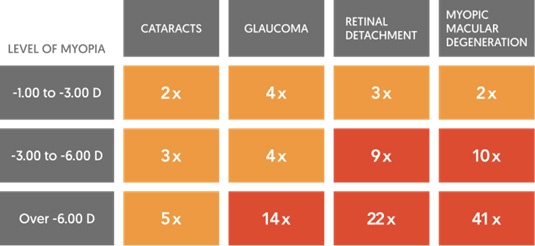
As illustrated from the table above, the likelihood of developing these eye diseases across the lifetime of a person increases dramatically the higher the myopia power is.
Recent studies have found that every 1D (dioptre) increase in myopia increases the risk of myopic maculopathy by 67% and myopic maculopathy is an irreversible blindness!
It is important to know that the purpose of Myopia Control is to slow down the progression of myopia (eexpertly in children from age or 6 to 13) but there are no known methods that can completely STOP the progression of myopia.
However, the current evidence-based options that are available will be listed in “How to Reduce Myopia Progression”.
The five strategies we provide here is:
With the above five strategies, we recommend discussing with our optometrist to see which one is best for you!
Recent studies have found that Myopia tends to develop faster with excessive near work (e.g., reading, studying, computers, tablets etc.), and not enough time spent outdoors in the sun.
Hence, the guidelines are:
Following these five tips will help with slowing down short-sighted progression.
Orthokeratology, or Ortho-K, is a therapy that allows you to enjoy being able to see during the day without needing to wear glasses or contact lenses. This all happens without any surgical intervention and it is all fully reversible too.
It is a type of rigid gas permeable contact lens that helps improve your sight while you sleep, and it does so by gently reshaping the surface of your cornea, a little bit like braces, but just for the eyes. It has been designed to be worn while you sleep and will give you clear vision during the day once you have taken out the lenses in the morning. One of the key benefits of Ortho-K, is the ability to be fitted on young children, as early as the age of five.
Additionally, it has been shown that Ortho-K lenses can reduce the progression on average by approximately 50%, however it has been anecdotally suggested to halt the progression up to 90%!
Current medical researchers suggest that myopia is worsened due to images focusing further behind the peripheral retina, and this encourages the eyeball to grow longer. Ortho-K allows both the images in the peripheral retina to be focused in front while having the central retina to focus the same, this will slow down the elongation process of the eyeball and therefore, reduce the rate of myopia progression and thus controlling myopia.
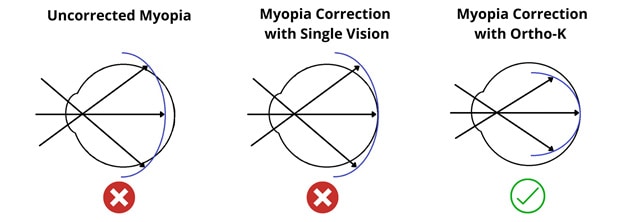
See the Ortho-K page for more information about the Ortho-K Programme at A+ Optometry.
Historically, the only options of myopia control spectacles were bifocals and progressive lenses. However, this has changed when the Hoya’s MiyoSmart with D.I.M.S. technology was launched in 2020.
The traditional bifocals and progressive lens have been proven to slow down myopia by up to 33%, but this data appears to be only valid for a limited group of patients with certain eye conditions. This means for most patients having these options makes no significant difference compared to single vision lenses. Hence, the options to correct myopia effectively with spectacle were very limited.
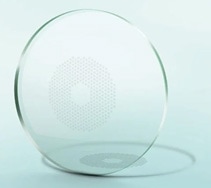
The Hoya MiyoSmart lens has been proven to slow down myopia progression by 60% for all myopic patients and it can be fitted into most spectacle frames.
Unlike traditional bifocals or progressive lenses, MiyoSmart lenses provide Myopia Control by refocusing the peripheral rays evenly to the front of the retinal, while keeping the rays always focused on the central retinal. This has been recognized as what slows down the elongation of the eyeball. Hence, effective myopia control.
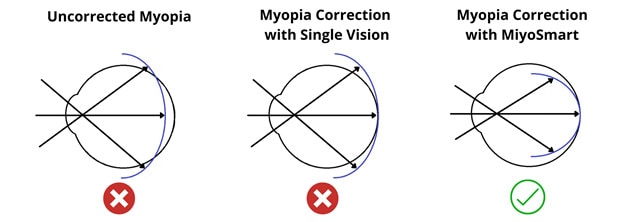
In the last few decades, Atropine eye drop has been recognized to be an effective option in Myopia Control and it has become a more and more popular option for Myopia Control.
The original prescribed dose for Atropine was 1%, this dosage was known to be very effective at Myopia Control, however it does come with a few undesirable side effects. Unfortunately, the effect of using the Atropine 1% drop is the dilation/expansion of the pupil and extreme blurriness for near tasks. This means the patient who instilled this drop will have constant glare issues (due to dilated pupils) and difficulty with reading up close. These side effects are quite undesirable for school age children.
Fortunately, there have been more studies done in the recent years that suggest a lower dose Atropine can still offer a good amount of myopia control without the significant amount of glare and blurriness up close. The recommended dosage as of most recent research is Atropine 0.025% or 0.05%.
Atropine is sometimes used in conjunction with the other treatments like Ortho-K or soft contact lens options. However, there are still many areas yet to be explored with the use of Atropine treatment, this is eexpertly so with regards to how effective it is in combination with the other strategies we had suggested in this section and there are still many ongoing researches exploring this area. What we do know is that if the Atropine 0.025% used by itself will provide an approximate 33% reduction whilst Atropine 0.05% it will provide an approximate 50% reduction in myopia progression.
The mechanism of why atropine helps with myopia progression is not fully understood and is still being debated in the scientific community.
Soft Myopia Control Contact Lenses is another useful tool we have to fight against myopia progression. This option is eexpertly helpful if patients are not suitable for Ortho-K.
There have been several types of soft contact lenses released in the market that have been proven to help with Myopia Control. One of the most recent FDA approved solutions is Coopervision’s MiSight contact lenses. Whilst there are a few other brands of contact lenses that have also been shown to be similar in efficacy, most of them are off labels. Overall, the efficiency of soft myopia control contact lenses available in the market is at approximately 50%.
Similar mechanism with Ortho-K lenses and MiyoSmart, these soft contact lenses work by shifting the peripheral rays to the front of the peripheral retina whilst keeping a focused point in the central retina, ultimately slowing the elongation of the eyeball.
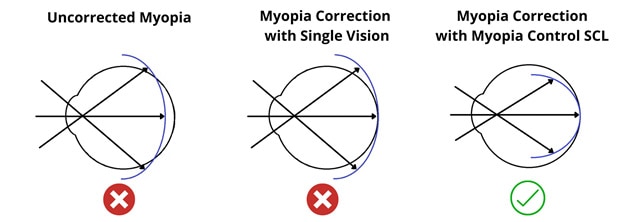
The above information is a summary of the Myopia Control strategies we provide at A+ Optometry. We strive to be at the forefront of new research and technologies which enable us to provide better eyecare for not just our younger generation, but to all generations in your family!
Furthermore, a child does not have to be myopic to start myopia control. This is because a child can be much less hyperopic (long-sighted) compared to their age normal group which indicates that they are more likely to become myopic when they grow older. These groups of children are what we call “Pre-myopes”. Whilst we do not necessarily need to start using strategies like Ortho-K, or myopia control spectacles. We would recommend lifestyle changes that limit the time in front of devices, more times outdoors in the sun and taking regular breaks from reading and near tasks (See How to Reduce Myopia Progression).
A study published in 2013 that had found that:
Furthermore, children that spend 3 hours or less each day with near work (excluding school time) in their leisure, or homework are more likely to stabilise by the age of 16.
Ultimately, once the myopia control is no longer needed, we always recommend having an eye examination at least once every 2 years to make sure the eyes are maintained healthy.
If you are concerned that your child to have vision issues or worried about the risk of Myopia?
Book an appointment to see us at A Plus Optometry.